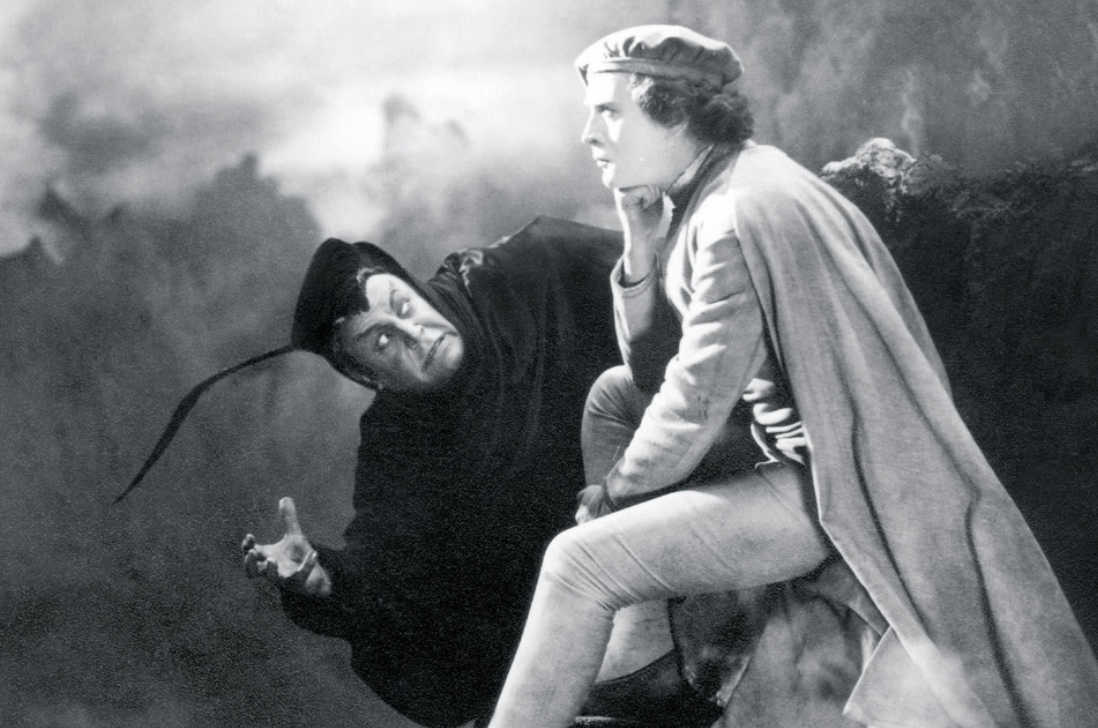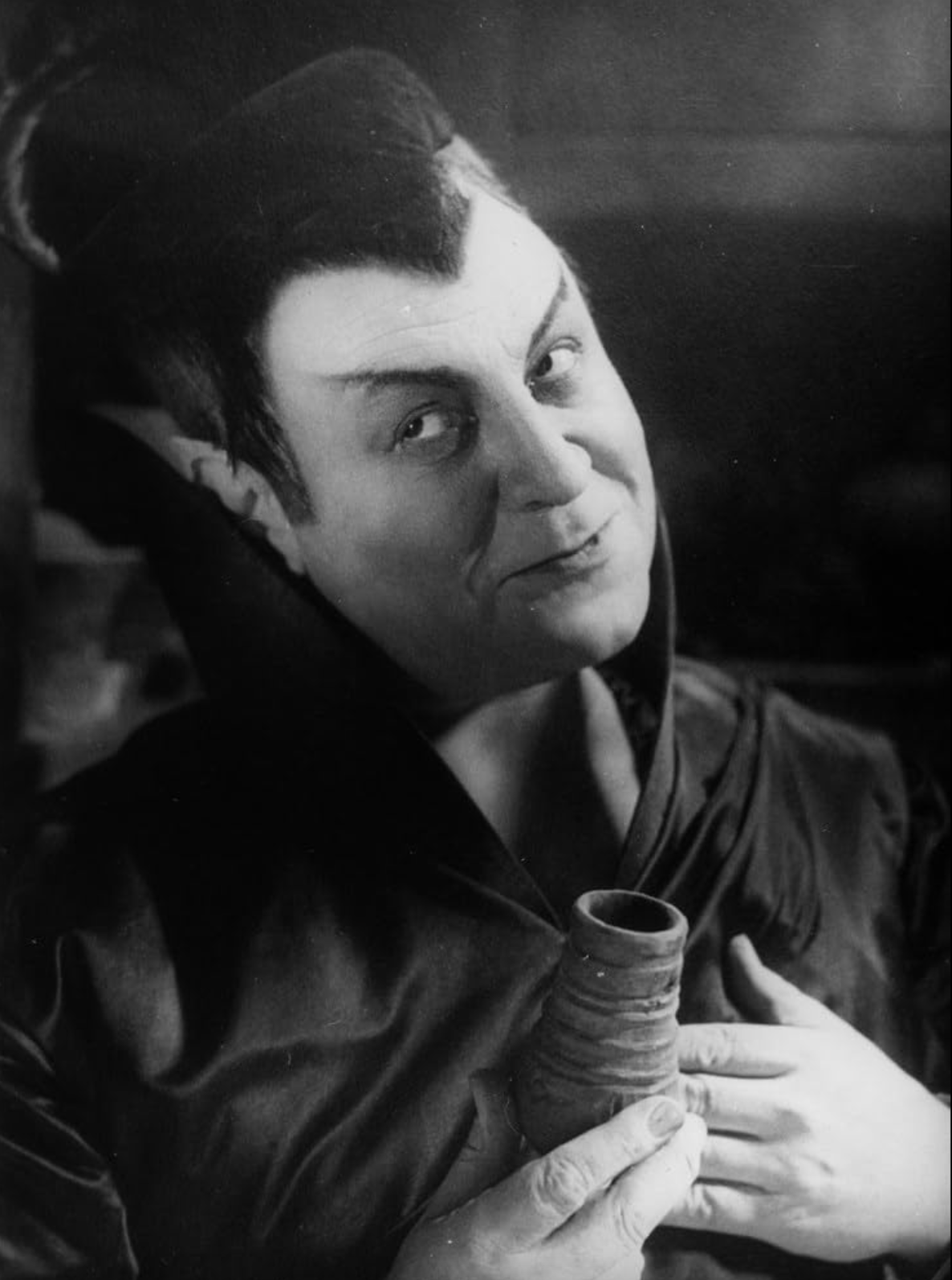
Faust (1926)
The Darkness and the Light
Mary Gaitskill introduces f. w. Murnau’s 1926 horror film Faust at light Industry.
By FERN PALTROW
08.21.2023
The first time I went to Light Industry was on a first date.
We rode the L from Union Square, and my date, a street performer I’d met, well, on the street, looked down at the man seated next to us, looked back at me, and whispered resoundingly, “He’s reading The Lightning Thief.” The man looked up at us, scandalized.
We were going to see Rubén Gamez’s The Secret Formula, an indictment of the United States’ imperialist expansion into Mexico, and one of the most influential films of the Latin American avant-garde.
The film held quite a grip on my date, who would periodically slap his knee and laugh the words “HA HA” into the audience. I was so amused by his lack of concern for viewing etiquette that I absorbed little of the film—though I can still recall the scenes of many sausage links traversing the screen.
When the lights went on, my date said, “Powerful.”
He suddenly fixated on a short, older man two rows beyond ours and yelled, “Wasn’t that fantastic? Wasn’t that just genius?”
The man, flustered, replied, “Oh—well yes,” and smiled uncertainly.
“That’s a great suit,” my date continued, “I love the scarf. Spectacular glasses frames too. You really know how to pull together a fit.”
“Thank you,” said the man.
We left the building. My date told me his thoughts on the genius of the film, and we meandered to a little footbridge over the Newtown Creek.
“It’s full of shit,” he said of the creek, and indeed it was—full of sewage and oil and oozing ten sensations of tar. Industrial lights danced along the slickness.
“It’s beautiful,” I said, and my date said “Yes, it is.”
- - -
Founded in 2008 and located in Williamsburg, Brooklyn, microcinema Light Industry holds weekly screenings and events, often in collaboration with an invited guest. Its directors, Thomas Beard and Ed Halter, or as the sculptor and critic Paige K. Bradley has affectionately coined them, the “light industrialists,” meld the worlds of contemporary art, experimental cinema, and documentary with the goal of creating novel formulae for the presentation of cinema. Admission is free, with a $10 suggested donation.
Shortly after that first, somewhat silly foray into the world of Light Industry, my Long COVID progressed to the point of making it difficult for me to leave my home.
From my bed, I longed to go back to Light Industry, among a great many other, impossible things. I wanted to become a regular there. I had seen many films in film school, but Light Industry reminded me of the movies I had seen outside of class, illegally screened by friends in basements and dorm rooms and my cozy communal living room at Farmhouse, movies like Stalker and Wild at Heart and Werner Herzog Eats His Shoe. The intimacy of those carve-outs manifests similarly at Light Industry, where there are only 75 elbow-to-elbow seats. Moreover, there is a certain affinity. The people who attend are there because they want to be, because they care about movies, because they believe that all forms of cinema, even, or especially, if those forms run contrary to the mainstream, are worthy of being shown and discussed. Beard and Halter built Light Industry from the ground up and will likely continue running the show until they are no longer able to do so. Standing so consistently at the helm has allowed them to build a close rapport with a notably loyal audience, and the degree of care they put into their curation is always clear.
Recently, my health improved enough to return to Light Industry, just in time to catch F. W. Murnau’s Faust, introduced by Mary Gaitskill, on Tuesday, August 1st. It was only appropriate that my partial re-entry into the world of the living begin with images of corpses being carried to a charnel pit and a protagonist who forsakes victims of the plague in order to enrich his own selfish desires.
I had just read Gaitskill’s interview in issue #243 of The Paris Review and couldn’t believe that such literary royalty—such cool-girl literary royalty—was materializing at Light Industry, where I could show up for free, where I didn’t have to be someone, be anyone, to gain access to brilliant speakers of relative notoriety and brilliant films of relative obscurity.
The freight elevator coughed up clusters of art scene types, and for a few-too-many minutes, all the knowledgeables stood smushed together on the landing, making erudite small talk. Finally, someone had an inspired idea to open the door, and we all burst into the venue gasping for fresh air—it emerges that even freethinkers fall prey to groupthink sometimes.
I was the only person in the tightly packed crowd to don a mask. My baggy jeans concealed a pair of unsightly compression socks, and I kept my water bottle, pulse oximeter, and emergency bag of electrolytes close at hand. I was already overheating. There was joy: here I was, poised to nourish my film-obsessed brain in a convivial atmosphere. And there was fear, about what particles that atmosphere concealed. I allowed myself to feel a tinge of hope: a month before, I wouldn’t have been able to make the journey, no less sit through a two-hour film. I wouldn’t have had the cognitive capacity to write an article. I leaned down and rapped my knuckles on the wooden floor. Don’t jinx it.
After everyone had settled in, the light industrialists took the floor, made a few announcements about their upcoming programming, and handed the mic to Gaitskill.
“I have never done anything like this before,” she said quietly, “but you don’t have to be a cinephile to talk about what is beautiful in this film.”
Faust is a silent film that chronicles the devil visiting a lethal plague upon a small village, and an elderly scholar named Faust who makes a pact with the demon Mephisto in exchange for the ability to heal those afflicted. Only, Faust gets diverted: he renegotiates the terms of the pact so that instead of using his powers to heal the suffering masses, he uses them to benefit himself: he grants himself eternal youth, indulges in all manner of worldly pleasures, and pursues the innocent maiden Gretchen—all to disastrous effect. The movie is based on the German legend of Faust, which dates back to the 1500s and has since manifested in a diverse range of media.

Faust (1926)
Gaitskill first came into contact with the legend as a young girl, when she heard the opera version on her father’s record player. She discussed the differences that exist between the most famous interpretations of Faust, and the degree of faith the movie holds to the tragic play by Goethe. She described Murnau’s visual mixing of good and evil, and how those visual cues overlap (sometimes literally, via superimposition) and contradict one another, raising the question, “Is there such a thing as true good, true evil?”
“Oh, and the faces that Satan makes!” she cried suddenly, pausing her speech to reenact the terrifying visage of the demon Mephisto. She shared her observation that Mephisto’s sword “protrudes like a tail, or like a dick going the wrong way,” and highlighted the irony of entrusting the devil to help cure people of the plague. She noted the “repeat images of dark cracks.”
A nasal voice rang out—“YOU’RE TELLING US THE WHOLE STORY! Don’t tell us the whole story. We want to hear a comparison of Murnau’s version to the Eisenstein version.”
“It doesn’t matter,” Gaitskill replied without missing a beat. “It doesn’t matter. The images are what matter.”
She resumed her speech—“Love is a comedy. A nasty comedy”—and, at its end, concluded that Faust demonstrates “how love, even if it is powerless to change anything, can transform everything in a moment, even if it is only for a moment . . . possibly more than a comparison to Eisenstein.”
Zing! She walked off the stage. Everyone laughed and clapped, delighted with her deft handling of a less than respectful customer.
The lights went off, and so began a two-hour visual, sonic, and satirical feast.
Faust is billed as a horror movie, but I and the rest of the audience all seemed to be on the same page: this was a comedy, a mix of intentional camp on the part of Murnau, and perhaps a level of unintentional camp resulting from the age of the film and the cultural shifts that have occurred in the decades since its creation. I would venture that Faust only gets funnier over time.

Faust (1926)
“Don’t touch me, whore, your lover has murdered me,” spits Valentin with his last dying breath.
This is a film about indulgence and the human desire for more . . . and more, and more, and more. As Gaitskill writes in “A Fairy Tale of Love,” the Substack post that inspired the screening, it is about “want and being destroyed by want.” Faust is insatiable. But what really astonished me about Faust was how the extravagance of the characters’ desires was reflected in every other element of the film. The actors gave the most outsized, expressive, rip-roaring performances. There was an opulence and luxury to the texture of the film. I found my attention drawn to the fabrics of the costumes, the intricacy of the handmade model landscapes, the extreme ornamentation of individual objects, and the iconography of the church. The set must have been a veritable expanse: there were so many actors and so many extras, all exquisitely choreographed.
The word that came to mind was intention. It seemed that Murnau and his collaborators were trying to push the limit for what was possible for film within the confines of their time. Indeed, Roger Ebert writes, “Murnau and his contemporaries were inventing their techniques while they were using them.”
I heard SNL’s Stefon echo in my head—“This movie has it all. Satan, elephants, chemical explosions, and a man who takes bites out of a cheese wheel and chews with his mouth open whilst cheering on the execution of an innocent.”
In the midst of writing this piece I met a friend for coffee, and when I told him about the movie, he said, “A lot of that probably wouldn’t be legal, now.” It was an appropriate remark: Lotte Eisner wrote that the actress who played Gretchen “had to spend hours tied to the stake, with flames leaping round her from 20 lycopodium burners. When she fainted, she was not acting.”
Scholarship certainly exists around Faust, but it is a surprisingly small body of literature considering the depth and breadth of the project. It is an underexplored and underappreciated film, ripe for further analysis and interpretation and, most critically, simple enjoyment.
I am thus grateful to Gaitskill and Light Industry for ensuring this bygone film does not fade from contemporary consciousness.
When the event was over, the art-scene types spilled into the street.
“Two weeks, two hecklers at Light Industry, I guess,” someone sighed.
And really, that was the beauty of it. That was why I wanted to return with greater frequency—to go to Light Industry was to flirt with the unexpected, the delectably eccentric, and maybe the absurd, too.

Faust (1926)
